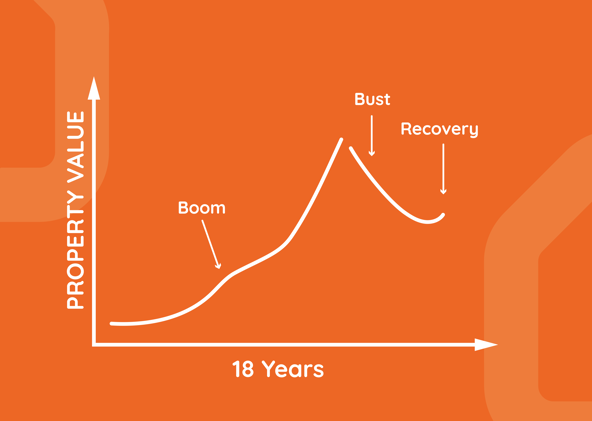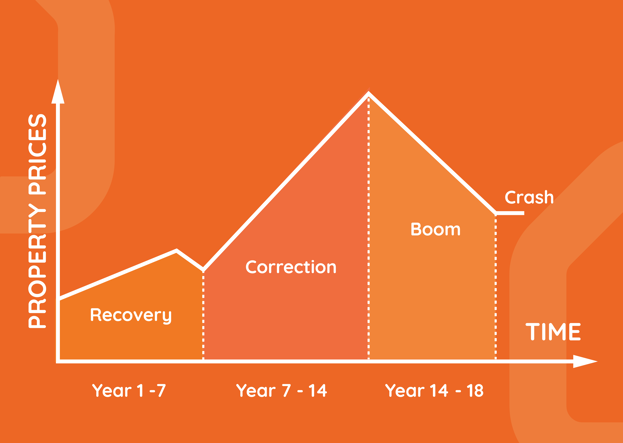
Highlights |
|
Imagine you could predict if property prices were going to go up or down. That would make you a better property investor right?
The 18-year property cycle can help you do this, which is why it is critical to understand if you are or want to be a property investor.
This article explains what the 18-year property cycle is and what the different stages are. We’ll then explain what stage we are currently at in 2023 and how you may be able to use the cycle to make more money from property.
What Is the 18-Year Property Cycle?
The 18-year property cycle is the idea that property prices will rise and fall over time in a relatively predictable pattern.
The cycle sees property prices increase over a protracted period and gradually gain momentum.
Eventually, the momentum becomes unsustainable and the market rapidly collapses. House prices drop and take time to recover.
As they begin to recover, the market confidence returns and the cycle begins again.
On average, this pattern usually repeats itself every 18 years.
The phenomenon was first identified by economist and author Fred Harrison. He analysed hundreds of years of data and found that the average length between boom and bust periods in the property market was 18 years.

It’s important to point out that the property cycle is just an average estimate. Cycles may be longer or shorter, depending on a wide range of socio-economic factors.
What Causes the UK Property Cycle?
The 18-year property cycle is caused by supply and demand of property.
In other parts of the economy, supply and demand temper each other.
For example, if demand for a product increases, then its price increases. This usually means more companies will be set up to manufacture that product and meet the demand because it is profitable. This causes supply to increase, which makes the product cheaper.
Alternatively, the product may become so expensive that people simply stop buying it, which forces the price down.
There are two main reasons this doesn’t happen with property:
-
Property is built on land and there is only a finite amount of it that can be used for property development. You cannot create more land. This limits supply.
-
Everyone needs a home to live in. Whether you own it or not, you need somewhere to live. This drives demand.
This means that supply struggles to meet demand, causing property prices to increase above wages and inflation.
During good economic times, people have more money to spend. Many choose to put it into property because they know it will provide a good return.
This inflates property prices, encouraging more people to invest in property. This causes property values to spiral upwards.
Eventually, residential property prices increase faster than wages, and it becomes unaffordable for most people.
At this point, the property market will crash, and prices will fall rapidly.
But eventually, wages increase and catch up with house prices. This makes property more affordable, and the cycle starts again.
The Four Property Cycle Stages
There are generally four stages to the UK property cycle:
-
Recovery
-
Correction
-
Boom
-
Crash

Let’s look at each in detail.
Years 1 – 7: The recovery stage
This phase begins at the end of the last crash, after house prices have reached their lowest point.
This period is characterised by:
-
Expensive lending
-
Low levels of construction activity
-
Moderate supply and demand
-
Sideways house prices followed by a gradual increase
-
Very few buyers or sellers
-
Only experienced investors are buying
Supply is high at this stage. That’s because many amateur investors have sold their properties. They have been spooked by the recent crash and want to avoid losing more money to the property downturn.
Only a small number of experienced investors buy property during this time. They are looking for bargains and are willing to make risky investments because they know the gains they can make.
However, it’s a difficult time to buy because lenders are likely to have tightened their lending criteria due to the recent downturn.
But as market confidence grows, more buyers enter the market. This causes prices to start to increase gradually.
A good sign that the recovery is underway is that institutional investors have begun buying property again.
They are experienced enough to buy when the market is at a low point. But they are also relatively risk averse and only purchase property when the market is growing.
The correction stage
This is a slight decline that happens after the recovery period but before the boom. It is sometimes called the mid-cycle dip. It can be caused by early buyers selling their properties to cash in on their profits. This results in a brief supply surge. It can also be caused by socio-economic factors.
Years 7 – 14: The boom stage
Shortly after the correction stage, demand will often return even stronger.
This stage is characterised by:
-
Increasingly cheaper lending
-
Increasing levels of construction activity
-
High demand
-
Rapidly increasing house prices
-
Lots of buyers and sellers
-
An influx of amateur property investors
As prices increase, lenders make mortgages more affordable, and there is increased competition between lenders.
Amateur investors see the gains that property investors are making and that the price of borrowing is coming down.
They see property as a low-risk, high-return investment, and so decide to enter the market.
The construction industry also booms, and building projects go full steam ahead.
At the same time, media reports begin to appear, sensationalising rising house prices.
This encourages even more people to invest in property.
House prices begin to increase significantly faster than wages.
As the market approaches its peak, it begins to spiral out of control.
Banks provide increasingly cheap mortgages, people are willing to pay crazy money for property, and estate agents receive offers that are consistently over the asking price.
Years 14 – 18: The crash stage
Around the height of the market, some investors will go bankrupt because they are over-leveraged and have overpaid for their property.
Mortgage lenders quickly begin to tighten their lending criteria. The media also begin reporting this and market confidence collapses.
Prices drop rapidly, and more over-leveraged investors go bankrupt, forcing them to sell their properties. This creates an influx of supply, which drives prices down.
This stage of the cycle is characterised by:
-
Expensive lending
-
Cancelled construction projects
-
High supply
-
Falling house prices
-
Fewer buyers and more sellers
-
Panic selling amongst amateur investors
A higher bottom
Property prices always increase more than they fall. This means that when the market crashes it forms a “higher bottom”.
This low point is almost always higher than the previous cycle’s low and usually higher than the previous correction.
What is the winner’s curse?
When reading about the 18-year property cycle, you often read about something called the winner’s curse.
But what is this? It’s the idea that when there is an asset that is in limited supply, then only one person can buy it. But to buy it they need to pay the highest price.
In property, it usually means that when you buy at the housing market peak, you risk overpaying and losing money in the medium term.
Examples of Previous Crashes and Recoveries
While the property cycle isn’t precise, you can see evidence of it in previous property crashes and recoveries.
These examples highlight that any fall in house prices is usually short-term. They often begin to recover within a year.
Here are some examples:
The 1950s
The period after World War 2 saw property values increase rapidly. But in 1953 they crashed due to high interest rates and too many over-leveraged buyers. This crash was relatively short and house prices started to rise again in 1954.
The 1970s
UK house prices rapidly increased during the 1960s but crashed in 1971. This was blamed on a number of socio-economic factors including the oil crisis and the introduction of the decimal system.
The late 1980s
A similar pattern occurred in the 80s. The crash came in 1989. The downturn was blamed on the recession and the introduction of the poll tax. House prices began to grow again in 1990.
The 2000s
From 1996, UK house prices went through a period of exceptional growth. By 2007, the average house price in the UK had increased by more than 250%. However, this was followed by a long, sharp period of declining house prices. This was caused by global economic factors linked to the property sector like the sub-prime mortgage crisis and the credit crunch.
Why Is It Important to Understand the UK Property Cycle?
Understanding the property cycle is critical for property investors.
Once you understand property cycles, you’ll know that:
-
Property prices don’t increase smoothly — they go up and down.
-
Property prices always go up in the long run.
-
You can ignore what the media says about property prices.
This will give you several advantages:
-
You’ll know why property prices behave the way they do, which allows you to make more informed decisions.
-
You’ll have confidence that you don’t need to sell your properties just because the housing market is experiencing a downturn.
-
You’ll be able to plan your strategy knowing that your property’s price is likely to drop at some point but then recover.
-
You won’t panic in a downturn or get caught up in the buying frenzy near the peak of the housing market.
Where Are We in the 18-Year Property Cycle?
It’s impossible to predict future house price movements, which means that it’s impossible to say for certain where we are in the property cycle.
As discussed, the cycle is only an average and an estimate. It doesn’t take into account specific socio-economic events.
The best thing to do is look at the facts and decide for yourself.
UK house prices have fallen for five consecutive months since the beginning of 2023. Average property values are now 3.2% lower than at the market’s peak in August 2022.
Mortgage rates have increased, as have borrowing costs, and property demand is down. In fact, it fell by 44% in November 2022.
This suggests that the UK property market is most likely in the recession stage.
However, this has happened earlier than it should have. According to the cycle, we should still have three years left.
The pandemic, Brexit and the Pound crashing in late 2022 may have all brought forward the property recession.
However, Fred Harrison predicts that the property market is actually experiencing a correction. He says that property prices will recover only to reach their peak and crash in 2026.
How to Make Money Using the 18-Year Property Cycle
There are a few ways that you can use the cycle to your advantage.
-
Invest long-term
Property values might go up and down, but in general, they increase overall. The average UK property price has risen by nearly 300% since the 1970s.
By planning to invest for several decades, you are likely to see steady growth that is above inflation.
-
Buy low, sell high
If you want to then you can try to time the market and buy when prices are at their lowest and sell before the peak.
The difficulty here is that predicting peaks and troughs is risky. You run the risk of losing money if you buy too early or miss the peak.
However, if you already plan to buy or sell a property then you may wish to accelerate or hold off on the process if you think the market will change soon.
-
Remortgage near the peak
Lots of investors remortgage to unlock extra property investment cash.
It’s easier to remortgage when the market is near its peak. This is when lenders offer the cheapest mortgage rates.
But don’t spend this money on a new property — you’ll lose out when the crash comes.
Instead, hold onto the money and wait for the crash to pass. You can then use the money to buy some bargain properties during the recovery phase.
House Prices Aren’t Everything
Understanding property cycles is critical for investors. It helps them to determine why the market is behaving how it is and to make better investment decisions.
When making a property business plan, it’s easy to get caught up worrying about when you will buy and sell your properties.
But it doesn’t help make you a better landlord and that’s an important part of owning a property.
That’s where EVO comes in. We provide a digital platform that takes the hassle out of being a landlord. It connects you with tenants and tradespeople so you can effortlessly manage communication, repairs, compliance and documents.
Being a landlord is tough. Luckily our blog has a range of articles that explain the basics of being a good landlord.
PHOTO BY EVO


